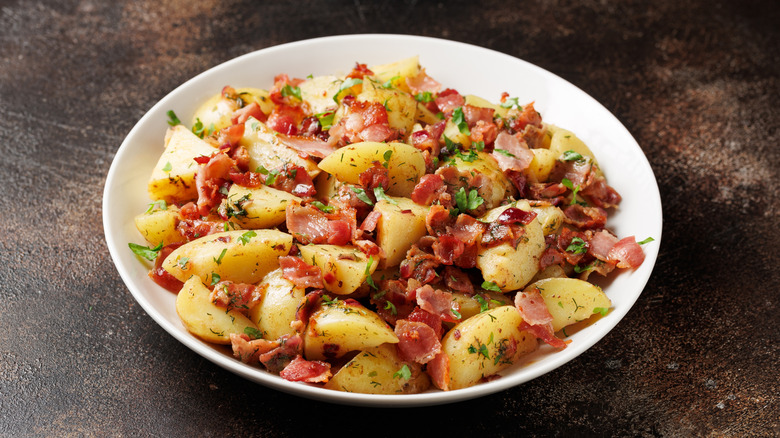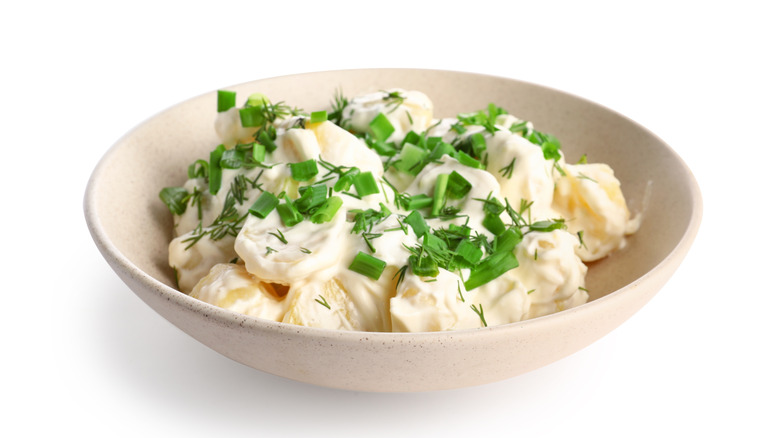How German-Style Potato Salad Differs From Its American Counterpart
Potato salad is one of those dishes that seems to show up just about everywhere, no matter where you are in the world. Of course, the versions vary. From Argentina's rendition with its staple sauce, chimichurri, to Korea's take, which swaps cubed potatoes for a creamy, mashed texture, potato salad is enjoyed in different ways around the globe. So, who do we credit for this bowl of pure comfort that has been interwoven in the cuisine of so many cultures? The origins of potato salad are often traced back to Europe, particularly to Germany, which explains why the German version, Kartoffelsalat, is one of the most influential. It is believed that German immigrants brought the dish to North America in the 19th century. America then went on to improvise and create its own, dare we say, creamier version. This is why there's quite a difference between the two, but the most immediately noticeable is the use of eggs, or lack thereof. It's hard to imagine American potato salad without some mashed, hard-boiled eggs, but traditional German potato salad skips them entirely.
Another glaring difference between German potato salad and its American counterpart is the use of mayo. Just like Italy's version of potato salad skips the mayo, Germans also choose to go sans mayo. And for anyone who has ever slipped a bite of American potato salad into their mouths, they know it's a can't-do-without-thou ingredient. Though these two are the most stark and arguably the most crucial differences, they're not the only ones. A few more nuances make each version distinct in its own right.
German potato salad
An important ingredient that you'll find in a German potato salad that is missing in the American version is some crispy, fried bacon. After rendering the fat, chopped onions are sautéed in it before being added to the salad. It is this step that gives German potato salad a unique edge and packs a punch of umami and meatiness.
As for dressing the potatoes, Germans opt for a vinegar-based approach instead of the mayo-and-egg combo found in most American versions. The vinegar adds brightness and helps balance the richness of the bacon fat and the potatoes. German potato salad also calls for a bit of sugar whisked with the vinegar and some mustard, salt, and pepper. These ingredients are all heated and then poured over the boiled and cubed potatoes before adding the fried bacon and onions.
Garnishes are optional, but if you're planning to whip up the German version and don't know what to go for, chives are commonly used as a garnish in this recipe. You can also season it with some parsley.
American potato salad
While not a compulsion, American potato salad is typically made with russet or Yukon Gold potatoes. Vinegar, onions, sugar, and mustard are common in both American and German styles. The German version uses a clear vinegar, whereas this one leans on white wine vinegar. Onions appear in both, though here they're fresh red onions for a bit of crunch, compared to the cooked onions used in the German take. An unexpected ingredient sometimes added to the American version, aside from egg and mayo, is pickles, though they're optional. Much like the great pineapple-on-pizza debate, their place in this salad is hotly debated. Some say they add the perfect tangy crunch; others say keep them far away.
The ideal serving temperature of the two also sets them apart. German potato salad is usually served warm or at room temperature. American potato salad, on the other hand, is typically served cold. Despite some ingredient overlap, the dressing is what lends each version a distinct flavor profile. The German salad's bacon-and-vinegar base gives it tangy-sweet-savory depth and a meatiness missing in its American counterpart. In contrast, the American version has a more creamy texture and oozing richness from the eggs and mayo. Depending on your taste, one might win out, or both might end up charming your palate in different ways.


